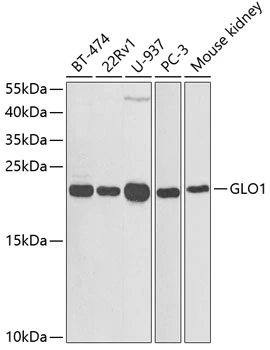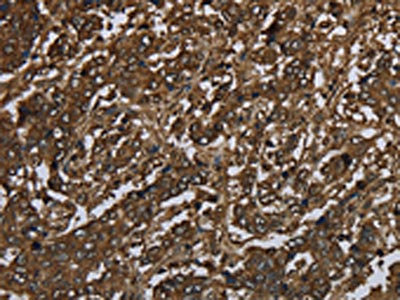Glyoxalase I antibody [GT552]
GTX628890
ApplicationsImmunoFluorescence, Western Blot, ImmunoCytoChemistry, ImmunoHistoChemistry, ImmunoHistoChemistry Paraffin
Product group Antibodies
TargetGLO1
Overview
- SupplierGeneTex
- Product NameGlyoxalase I antibody [GT552]
- Delivery Days Customer9
- Application Supplier NoteWB: 1:500-1:3000. ICC/IF: 1:100-1:1000. IHC-P: 1:100-1:1000. *Optimal dilutions/concentrations should be determined by the researcher.Not tested in other applications.
- ApplicationsImmunoFluorescence, Western Blot, ImmunoCytoChemistry, ImmunoHistoChemistry, ImmunoHistoChemistry Paraffin
- CertificationResearch Use Only
- ClonalityMonoclonal
- Clone IDGT552
- Concentration1 mg/ml
- ConjugateUnconjugated
- Gene ID2739
- Target nameGLO1
- Target descriptionglyoxalase I
- Target synonymsGLOD1, GLYI, HEL-S-74, lactoylglutathione lyase, S-D-lactoylglutathione methylglyoxal lyase, aldoketomutase, epididymis secretory protein Li 74, glx I, glyoxalase domain containing 1, ketone-aldehyde mutase, lactoyl glutathione lyase, methylglyoxalase
- HostMouse
- IsotypeIgG1
- Protein IDQ04760
- Protein NameLactoylglutathione lyase
- Scientific DescriptionThe enzyme encoded by this gene is responsible for the catalysis and formation of S-lactoyl-glutathione from methylglyoxal condensation and reduced glutatione. Glyoxalase I is linked to HLA and is localized to 6p21.3-p21.1, between HLA and the centromere. [provided by RefSeq]
- Storage Instruction-20°C or -80°C,2°C to 8°C
- UNSPSC12352203

![IHC-P analysis of human prostate and stomach carcinoma tissue using GTX15747 Glyoxalase I antibody [Glo1a]. Antigen retrieval : heat induced antigen retrieval was performed using 10mM sodium citrate (pH6.0) buffer for 20 minutes Dilution : 1:800](https://www.genetex.com/upload/website/prouct_img/normal/GTX15747/GTX15747_1035_IHC-P_w_23060620_356.webp)


